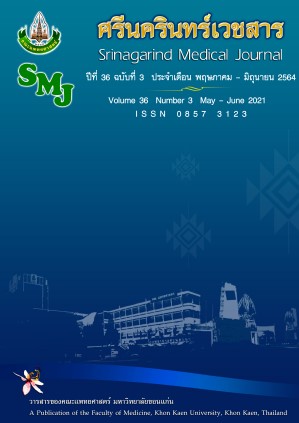Real Time Tele-Monitoring and On-Line Medical Direction for Inter-Facility Transfer in The Critically Ill Patients
Keywords:
Telemedicine; On-line medical direction; Inter-facility transferAbstract
Background and Objectives: The Tele-Monitoring system has been implemented in all public health hospitals in Khon Kaen Province since 2014. In 5 years later, On-line medical direction program has been initiated to provide real-time consultation for the healthcare personnel during transferring patients. The purposes of the system are to increase the confidence of providers and to enhance the safety management during inter-facility transfer. This study aimed to analyze the association between Tele-Monitoring system used and mortality in first 24 hours.
Methods: It was a retrospective cohort study. The critically ill transferred patients from the rural hospitals to Khon Kaen hospital from October 2018 to September 2019 were enrolled. Descriptive Statistics were used for descriptive data. The association between Tele-Monitoring used and mortality within the first 24 hours was analyzed by Chi-square. P-value <0.05 was set for statistical significance.
Results: There were 3,750 patients enrolled, 2,867 (75.5%) used the Tele-Monitoring system during inter-facility transfer. The mean age was 61.80±16.58 years, male sex was 63.7% and 11.1 % were trauma patients. The most common indication for the Tele-Monitoring used was ESI level 1. The mortality within first 24 hours was not different between Tele-Monitoring used and in non Tele-Monitoring used groups (p=0.978).
Conclusion: The Tele-Monitoring system is a high investment and maintenance of inter-facility. However, the Tele-Monitoring and On-line medical directions will help patients to receive treatment promptly along transferring with reducing death or disability.
References
2. Nagatuma H. Development of an emergency medical video multiplexing transport system: Aiming at the nation wide prehospital care on ambulance. J Med Syst 2003; 27(2): 133–40.
3. Ki Young Kim, Yun Kwon Kim, Kang Hyun Lee, Suk Joong Yong. Factors affecting the use of a realtime telemetry system in emergency medical services. J Telemed Telecare 2011; 17(8): 441–445.
4. Yun Kwon Kim, Ki Young Kim, Kang Hyun Lee, Sang Chul Kim, Hyun Kim, Sung Oh Hwang, et al. Clinical Outcomes on Real-Time Telemetry System in Developing Emergency Medical Service System. Telemed E-Health 2011; 17(4): 247–253.
5. Munk M-D, White SD, Perry ML, Platt TE, Hardan MS, Stoy WA. Physician medical direction and clinical performance at an established emergency medical services system. Prehosp Emerg Care 2009; 13(2): 185–192.
6. Kasitipradith N. The ministry of public health telemedicine network of Thailand. Int J Med Inf 2001; 61: 113–116.
7. ราชกิจจานุเบกษา. ประกาศคณะกรรมการการแพทย์ฉุกเฉิน เรื่อง อำนาจหน้าที่ ขอบเขต ความรับผิดชอบ และข้อจำกัดในการปฏิบัติการแพทย์ ของผู้ช่วยเวชกรรมตามคำสั่งการแพทย์หรือการอำนวยการ [Internet]. 2556. [cited Nov 4, 2020]. Available from: http://www.ratchakitcha.soc.go.th/DATA/PDF/2556/E/033/38.PDF
8. Critical events during land-based interfacility transport- ClinicalKey [Internet]. [cited 2020 Nov 4]. Available from: https://www.clinicalkey.com/#!/content/playContent/1-s2.0-S0196064413016533?returnurl=https:%2F%2Flinkinghub.elsevier.com%2Fretrieve%2Fpii%2FS0196064413016533%3Fshowall%3Dtrue&referrer=https:%2F%2Fpubmed.ncbi.nlm.nih.gov%2F
9. Srithong K, Sindhu S, Wanitkun N, Viwatwongkasem C. Incidence and risk factors of clinical deterioration during inter-facility transfer of critically ill patients; a cohort study. Arch Acad Emerg Med [Internet]. 2020. [cited Nov 4, 2020]; 8(1). Available from: https://www.ncbi.nlm.nih.gov/pmc/articles/PMC7587985/
10. Almadani B, Bin-Yahya M, Shakshuki EM. E-AMBULANCE: Real-Time Integration Platform for Heterogeneous Medical Telemetry System. Procedia Comput Sci 2015; 63: 400–407.
11. Yan Xiao, Gagliano D, LaMonte M, Hu P, Gaasch W, Gunawadane R, et al. Design and evaluation of a real-time mobile telemedicine system for ambulance transport. J High Speed Netw 2000; 9(1): 47.
12. Kwak M, Kim J, Shin I, Shin S, Song K, Suh G, et al. Real-time medical control using a wireless audio-video transmission device in a pre-hospital emergency service in Korea. J Telemed Telecare 2009; 15: 404–408.
13. Han S, Lim H, Noh H, Shin HJ, Kim GW, Lee YH. Videotelephony-assisted medical direction to improve emergency medical service. Am J Emerg Med 2020; 38(4): 754–758.
14. Charash WE, Caputo MP, Clark H, Callas PW, Rogers FB, Crookes BA, et al. Telemedicine to a moving ambulance improves outcome after trauma in simulated patients. J Trauma Acute Care Surg 2011; 71(1): 49–55.
15. Verma A, Gladstone DJ, Fang J, Chenkin J, Black SE, Verbeek PR. Effect of online medical control on prehospital code stroke triage. Can J Emerg Med 2010; 12(2): 103–110.
16. Sullivan F, Williams KA. Physician medical direction of emergency medical services. R I Med J 2013; 96(12): 28–30.
17. Aljerian N, Kimani P. Incidence and predictors of adverse events and outcomes for adult critically ill patients transferred by paramedics to a tertiary care medical facility. J Health Spec 2017; 5(4): 206-210.
18. Durairaj L, Will JG, Torner JC, Doebbeling BN. Prognostic factors for mortality following interhospital transfers to the medical intensive care unit of a tertiary referral center. Crit Care Med 2003; 31(7): 1981–1986.
19. Rishu AH, Aldawood AS, Haddad SH, Tamim HM, Al-Dorzi HM, Al-Jabbary A, et al. Demographics and outcomes of critically ill patients transferred from other hospitals to a tertiary care academic referral center in Saudi Arabia. Ann Intensive Care 2013; 3(1): 26.
20. Fan E, MacDonald RD, Adhikari NKJ, Scales DC, Wax RS, Stewart TE, et al. Outcomes of interfacility critical care adult patient transport: a systematic review. Crit Care Lond Engl 2006; 10(1): R6.
21. Ligtenberg JJ, Arnold LG, Stienstra Y, van der Werf TS, Meertens JH, Tulleken JE, et al. Quality of interhospital transport of critically ill patients: a prospective audit. Crit Care 2005; 9(4): R446–451.
22. Wiegersma JS, Droogh JM, Zijlstra JG, Fokkema J, Ligtenberg JJ. Quality of interhospital transport of the critically ill: impact of a Mobile Intensive Care Unit with a specialized retrieval team. Crit Care 2011; 15(1): R75.
23. Droogh JM, Smit M, Hut J, Vos R de, Ligtenberg JJM, Zijlstra JG. Interhospital transport of critically ill patients; expect surprises. Crit Care 2012; 16(1): 1–5.




